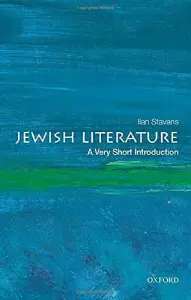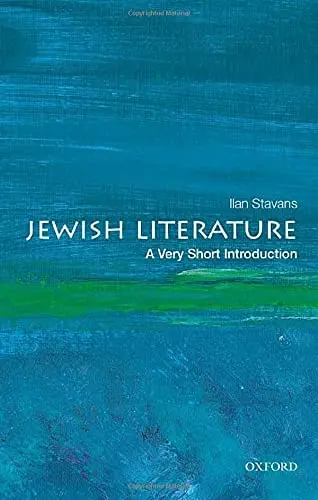 A Very Short Introduction: Jewish Literature by IIan Stavans
A Very Short Introduction: Jewish Literature by IIan Stavans
The story of Jewish literature spans the globe as well as the centuries, from the marrano poets and memorialists of medieval Spain, to the sprawling Yiddish writing in Ashkenaz (the “Pale of Settlement’ in Eastern Europe), to the probing narratives of Jewish immigrants to the United States and other parts of the New World. It also examines the accounts of horror during the Holocaust, the work of Israeli authors since the creation of the Jewish State in 1948, and the “ingathering” of Jewish works in Brazil, Bulgaria, Argentina, and South Africa at the end of the twentieth century. This kaleidoscopic introduction to Jewish literature presents its subject matter as constantly changing and adapting.
Yet, more than a dozen Jews have been recipients of the Nobel Prize for Literature, the latest being Louise Gluck in 2020. Jewish writers write stories, essays, novels, poems, memoirs, plays, letters, children’s books and similar artefacts. In fact, there are Jewish writers behind the modern graphic novel, and the superhero genre! In awarding the Nobel Prize to Bob Dylan in 2017, the Stockholm Committee celebrated his talent as a folk singer, that is, a musician and a balladist.
An important matter is raised by the author: in this day, this age, the term book might mean anything. The definition of book as an object with many pages is obsolete. In the early 21st century, books appear in multiple forms.
We return to history. In 1792, the French Enlightenment of liberté égalité fraternité were seen as an invitation to all members of civil society, including Jews, to join ideals of tolerance, in which the outcome was a process of civic emancipation and the slow entrance of Jews to secular European culture. Jews were granted full civil rights within a few years of the French Revolution.
The Jewish Enlightenment, or Haskalah, was an ideological and social movement that developed in Eastern Europe in the early nineteenth century and was active until the rise of the Jewish national movement in the early 1880s. Its partisans were known as maskilim. In certain senses, Haskalah was an extension of the eighteenth-century European Enlightenment, but it was centrally concerned with Jews’ political status and their relationship to European culture. Essentially, Haskalah sought to exploit the new possibilities of economic, social, and cultural integration that appeared to become available to Jews in the late eighteenth century with the removal of legal discrimination.
Jewish literature also includes the Yiddish language. In Europe, another Jewish centre was in development: Ashkenaz. It is a reference to Germany, Austria-Hungary, France, and the Pale of Settlement, the region in Poland, Lithuania, Latvia, Ukraine, Belarus and Russian in which the Russian czar allowed Jews to settle under particular restrictions. Yiddish (also called yidish taich the Jewish German and der mame loshen the mother’s tongue) was initially a mix of German and Hebrew written in Hebrew characters.
The systematic destruction of six million Jews and the culture that they had built for centuries in Europe – known in Hebrew as the Shoah – took place within a short span of time. Its reverberations are infinite. In the decades after 1945, a torrent of memoirs were published about the harrowing experiences. Unlike most modern Jewish literature, the narratives emerging from the Holocaust have to be taken on its own terms. It is not designed to be aesthetically pleasing. What matters is that it exists as a statement against oblivion.
Among the earliest narratives of Nazi persecution Anne Frank’s Diary of a Young Girl, tells the story of a precocious thirteen-year-old in Amsterdam living in a secret annexe with her family and four other people – chronicling her isolation in the rear of a 17th century canal house. Her father, Otto Frank, while determined to see this diary through to publication, excised all references to her growing up as a Jewess He was universalising her diary at the expense of Jewish particularism. There is much more we can say about Shoah and the Holocaust – it important for Jews to keep memory alive as many of the survivors of Shoah are passing over.
America has welcomed Jewish immigrants to its shores and hosts a significant cabal of Jewish writers. Saul Bellow translated Gimpel the Fool (Gimpel Tam in Yiddish into English – and suddenly, Isaac Bashevis Singer, a Yiddish author from Poland acquired a following. His youngest sibling, Moshe died in the Holocaust. Singer continued to write in Yiddish, and had an army of translators – a number of whom did not know Yiddish. American Jewish writers moved from writing immigrant narratives to explorations of the American Dream. The national ethic was work, work, work. The way to achieve that often sacrificed family, and Jews were no stranger to that.
Among the Jewish immigrants (and sons of immigrants), Norman Mailer was famous for testing conventional boundaries and norms regarding ethics and politics, fiction and history, sexuality and gender, high art and popular culture, freedom and repression-all within the context of the American experience. He wrote the “attempt to explain America was left to the sons of immigrants who, if they were vigorous enough, and fortunate enough to be educated, now had the opportunity to see that America was a phenomenon never before described, indeed never before visible in the record of history.”
Thus, Mailer became one of America’s most influential new Jeremiahs, excoriating the country and the people for failing to live up to the existential challenge and moral imperative of their individual and collective lives. As in the model of the Hebrew and Puritan Jeremiad, Mailer castigated and condemned; he promised apocalyptic catastrophe for moral and ethical failure, but he still held out the promise for ultimate redemption and renewal. In his remarkable experiment during the Vietnam era with the fluid boundaries between history and the novel in The Armies of the Night, he writes,
America-the land where a new kind of man was born from the idea that God was present in every man not only as compassion but as power, and so the country belonged to the people; for the will of the people-if the locks of their life could be given the art to turn-was then the will of God.
Mailer’s address to America includes multiple references to God, taking the story and meaning of America to a religious and transcendent dimension. The transcendent realm becomes a personal issue of selfhood, responsibility, and fulfillment. Individual and national mission cohere in the quest for transcendent meaning and purpose.
This reader knows little about Zionism and its history except it is about the return to the Promised Land. This book shares the story of the Lithuanian philologist and educator Eleizer ben Yehuda, who expanded the notion of aliyah – the Hebrew word for ascendance to the Promised Land – and said it was insufficient. One had to imagine life in a new language. Eleizer ben Yehuda published a number of pamphlets and participated in the first aliyah which took place between 1882 and 1903 during which approximately 25,000 – 35,000 Jews came from the Pale of the Settlement and Yemen. Yehuda forbad his family from speaking in anything except Hebrew. There is an interesting narrative of the second and third aliyah events.
From reading Shylock in Shakespeare’s Merchant of Venice (nowhere does it say that Shylock is a Jew in that play) to Martin Buber’s I – Thou, to Hannah Arendt’s Banality of Evil and Susan Sontag’s Essays, reveals significant contributions of Jewish literature. One comment on the rise and destructiveness of social media is worthy of consideration:
In the age of social media, literary criticism descends into shameless advertising. The capacity to read closely, to ponder contradicting ideas, and to sustain an argument is dramatically curtailed. Indeed, social media, in its engagement, is defined by distraction: it requires the user to nervously jump from one theme to another with little by way of connection. In such an ecosystem the act of criticism is easily understood as destructive rather than constructive. As a result, reading books, and doing so by keeping a steady literary diet, is the domain of the small educated elite whose interests do not align only with ephemeral cultural fashion. The truth is, this trend, while looking new, has been consistent since the Enlightenment: reading is an activity that, while aspiring to be democratic, is reserved for the very few. Still, the need to interpret — for example, to find meaning — in what is read remains a Jewish compulsion.
Available on Amazon

![]()

